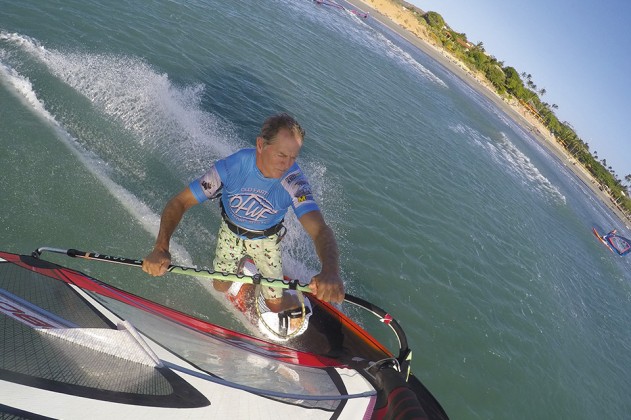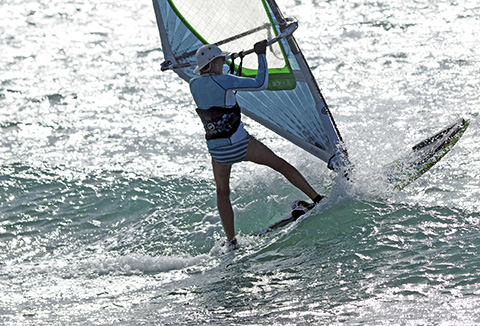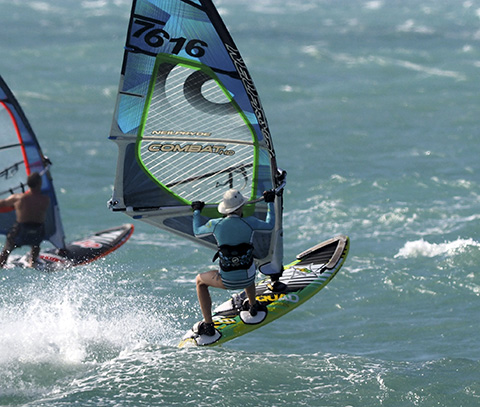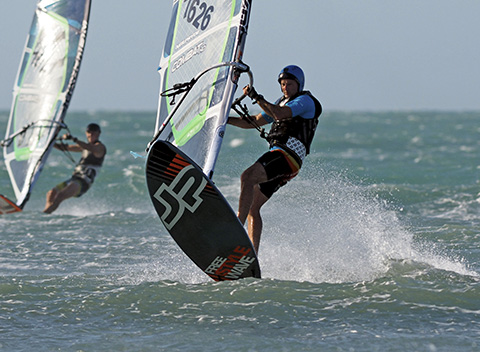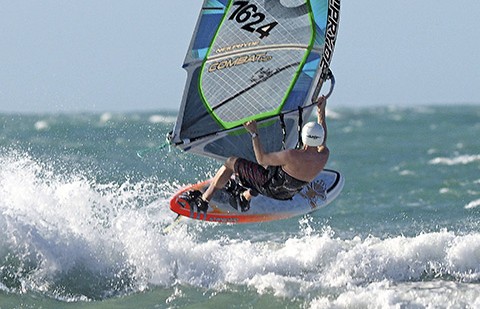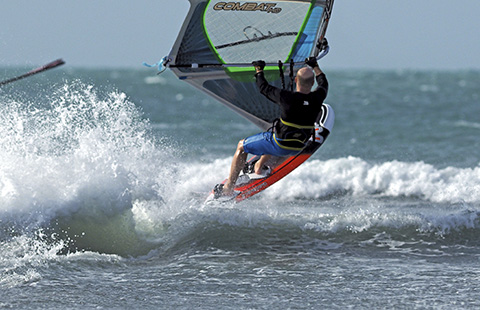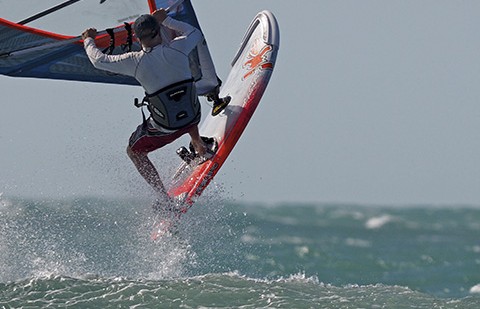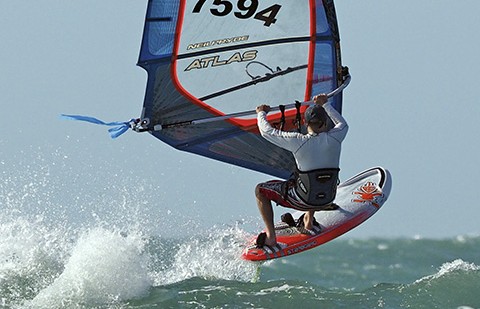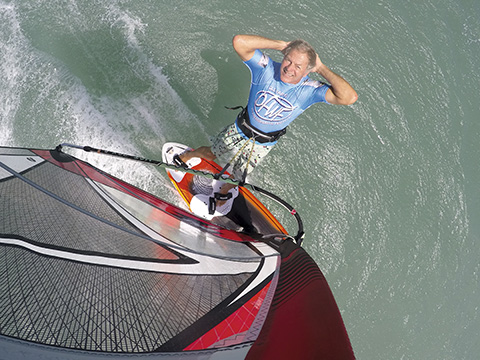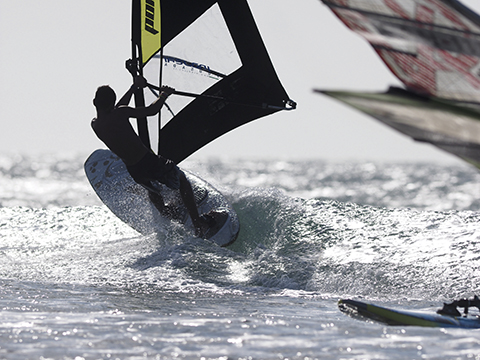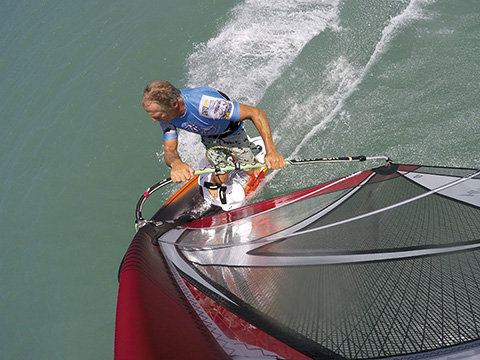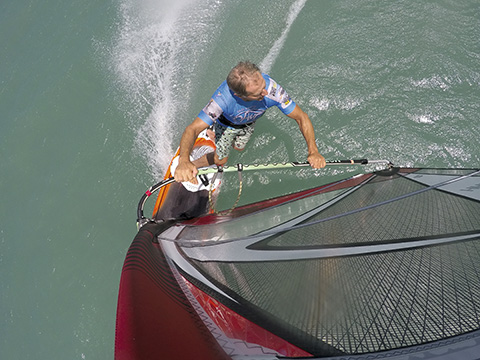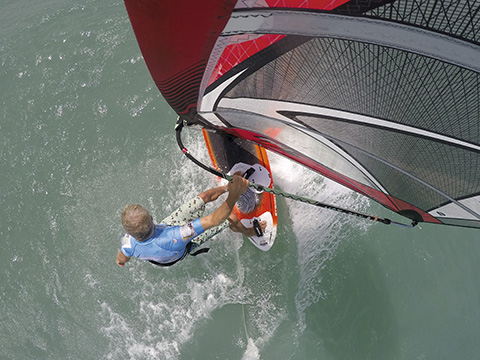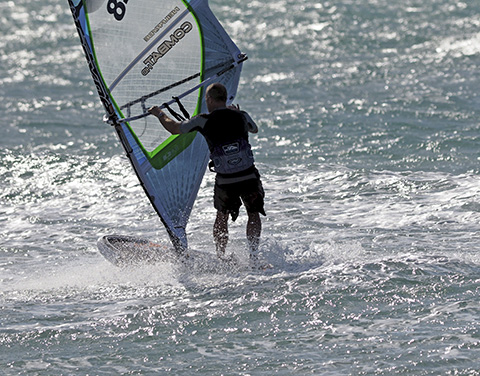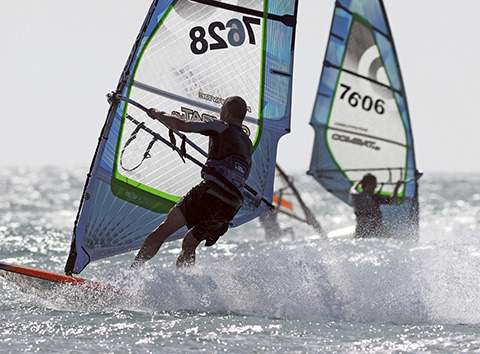STRONG WIND TECHNIQUES
Words Peter Hart // Photos Hart Photography
With winter storms being the main thread in this issue, it’s only fitting that Peter Hart should fall in line and examine the technical challenges of sailing in strong winds.
Those with a passing interest in pedagogy will be familiar with various teaching styles that coaches employ depending on the environment, the complexity of the move and who stands before them. For example there’s the intellectual approach involving detailed technical explanations for people who like words and won’t allow themselves to attempt anything remotely risky until they fully understand the mechanics. There’s the ‘monkey see, monkey do’ approach’ a.k.a. ‘mirror learning.’ It works for those who like to see the skill in its entirety and then just follow and imitate. It’s what kids do so naturally. And it’s what adults should do – and would do if they hadn’t got a mortgage.
A lesser known coaching approach but arguably the most effective in many advanced windsurfing situations where direct communication is difficult, is the FOFO method. Developed probably in the back streets of Liverpool in less affluent times, it’s an acronym for … ( I apologise for the vulgarity – but don’t shoot the messenger) … “F*** Off and Find Out.”
It’s not entirely a coaching cop-out but the premise is: “anything I tell you at this stage is totally irrelevant. The moment you launch into this screaming gale for the first time any tips and strategies dribble out your ears along with all logical thought and a lot of ear wax. So get out there, give it a go and see what happens.” Necessity being the mother of invention, a LOT
happens, not of all it seemingly positive, but violent mistakes are all part of the process. Brave/foolish people do well in the upper stages of windsurfing because they throw themselves into the maelstrom and put their bodies on the line. Thanks to a lot of FOFO-ing, the scary unknown quickly becomes vaguely familiar. They bring their fears under control and are then free
to loosen up and flourish …maybe.
But there’s a balance to be struck. A lot of people down my way have been doing this sport for years and will go out in absolutely anything. They’re not afraid, they’re perfectly competent but, without naming names, they don’t so much as ‘rip’ in strong winds as sail in and out. Too much FOFO-ing in conditions way above their head in the early days made them develop a bundle of get-out-of-jail survival techniques. And it’s when coping mechanisms overpower basic good technique that growth is permanently stunted.
Filling the Gaps
You may have heard of the Khan Academy. Salman Khan started tutoring his nephew in maths online. His YouTube clips were spotted, went viral and his methods are now a global phenomenon. One thing Khan noticed in the school system was that to pass grade 1 in maths, you needed to score 70%. To pass grade 2 you also needed to score 70%. Sounds reasonable BUT that’s two lots of 30% that you don’t know. So if you’ve been scraping a pass each time, you’re challenging the upper levels with more and more gaps in your knowledge. His methods ensure that kids attack the next concept with a full armoury.
Such is the plight of a lot of windsurfers as they confront strong winds. Gaps in their basic game make the sexy bits – the soaring jumps, the slashing rides and the screaming gybes – unattainable. Strong winds, like chop and gybes, expose technical flaws. You don’t need a host of new techniques; just make the basic ones better.
What is a ‘strong’ wind
We’re not talking tempests here. That’s a different game. Following the passage of Hurricane Jude some 18 months ago, I was driven to write a piece about the do’s and don’ts of storm riding. In that instance, I could have saved myself a lot of time and just written FOFO across all five pages. Most of it IS just about getting out there and developing fast, instinctive survival techniques.
The ‘strong’ wind I’m talking about starts at about force 6. For many advanced windsurfers 22-30 knots (force 6-7) is the ideal strength. You’re up to full speed on your favourite light, squirrely board and small, flicky rig, but you’re not hanging on. You’ve got control.
But for the improving windsurfer force 6 represents something of a watershed. It doesn’t seem like a big leap from the dreamy force 5 – but it produces twice as much pressure. Many things suddenly change.
- No board above 100 ltrs is really at home.
- Away from speed and slalom, most are on sails less than 5. Fantastic if you’re used to it – twitchy and ‘on off’ if you’re not.
- Wind speed differences in gusts and lulls are more severe.
- To sail at the speed of the wind so you enter moves with a light sail means you have to sail really fast usually over water which is anything but flat.
- There’s enough wind to support the board in the air – and to blow it out of the water.
It’s not survival wind but marks the point at which you have to hone and modify your technique in various ways.
// The low boom, short line combo produced some defensive and slightly old school measures.
// With the new set-up she planes straight into the fun zone.
THE PROGRESS OF LIZ
Liz’s progress in the strong winds was remarkable. Fantastically energetic she was in no way fazed by the conditions. However, her set-up wasn’t the best and it all stemmed from her waterstarting. She could only fly the rig by resting the boom on the back of the board so had to keep the boom low and the lines short. That set up leaves you too close to the rig, in catapult country, as you set out. Her defensive mechanism was to slide her front hand forward on the boom, put her front foot forward to match it and shove her back foot straight in the strap – safe but inefficient. Her whole game changed by learning a new waterstart technique, which did not rely on the back of the board and allowed her to put the boom up and lengthen the lines. Shedding nearly 20 ltrs from a 85 to a 69ltr board also made a massive difference.
Coming up, I’ve isolated the following areas, early planing, speed and stance, gybes and jumps and show where corrupt instincts infect progress.
My January articles traditionally have the scent of Brazil. This year is no different. Ten out of ten days of force 6 winds + for my recent clinic provided perfect laboratory conditions to observe people adapting to constantly strong winds. I thank the crew for their skill and perseverance.
Launch and plane
How someone launches and leaves the beach in strong winds tells you all you need to know about their kit selection, set-up, general confidence and chances of excelling.
Jumps, windward progress, energy levels all improve the less time you spend off the plane.
You’d have thought more wind would make getting away easier – but that’s not always how it works.
For someone my weight (88kg), the earliest planing scenario would be something like a 130 ish board, an 8.0 sail, flat water and about 15 knots of breeze. The big board sits high in the water, doesn’t push much of a bow wave and just slides onto the plane.
// Tail walking is usually the result of too big a board with too big a fin in too much wind – but to be fair to Ivan I think he was just putting the brakes on to come in.
The big rig has loads of leech twist and a wide sheeting angle. The power comes on gradually, so you don’t get defensive and can deliver a constant flow of power to the board. And of course you have a big fin to hoof against.
Now take the 85 ltr and the 4.2 in 25 knots. If the smaller board is allowed to sink, it pushes a wall of water and then needs a lot more power to bump it up and over.
A 4.2 has a relatively narrow wind band compared to an 8. Winds around the shore and the shore-break are gusty. In a lull of 15 knots a 4.2 just stops working.
The nature of the strong wind is that it hits the stationary sail like a bullet. You feel a real jolt in the arms. “I’m over-powered,” you shriek. No you’re not – but instinctively to avoid a catapult you hunker down and bend the arms. But if you pull the rig back and power up the tail, you head up and with only a tiny fin to resist the force, you crab sideways and stop.
Fighting the instincts
There’ll be a theme running through all the following strong wind advice. It’s not particularly technical. In fact when I wrote the ‘10 key points of Funboard Sailing’ for instructors back in 1982, it was number one – “GO FOR IT!” Or if you prefer: ‘Do get on with it!” “Don’t pfaff about.” Or simply “Grrrrrrr!”
On little kit, speed is your ultimate friend. If you can land on the board already sheeted in and moving thanks to a well timed running beach start, the board floats high (less drag), you have apparent wind and so are less vulnerable to lulls.
Give yourself an incentive. Try and get into the straps within 5 seconds or by the time you hit the first wave.
If that doesn’t work, look at the beach start technique.
If it still doesn’t work, look at the timing of the launch.
If it still doesn’t work tweak the set-up and examine the stance.
The Running Beach Start
There are beachstarts where you dig the fin in the sand, climb aboard and wait for the tide to come in. The version we’re after here, however, is the one where you land on the board hooked in and sailing.
On the shallow shelving sands of Jeri you gauge the brilliance of your starts by the depth of water you can launch in. If with a 20cm fin you launch in knee-deep water and ground out, you know you’re guilty of sheeting out and dropping the tail.
The key is to angle the board a few degrees off the wind, run, jump, land with your feet just in front of their relative straps, and within a half a second feel your harness load up. The force of your feet landing must be balanced by instant mastfoot pressure. Committing to the harness and relaxing is a huge part of strong wind sailing. The instinct to quash here is that of pulling in the front arm to depower and survive. Instead, with your hands well back on the boom, EXTEND the front arm to power up, drop the nose (and lift the fin) and accelerate.
And it’s as you accelerate and before you’re fully planing that you dive into both straps. Local Jeri freestylers do not perform a running start so much as a sprinting start. Thanks to thick, ‘slabby’ boards and explosive energy, they’re jumping on and planing in 6 inches of water – and then doing something aerial and unpronounceable within metres of the shore.
The Timing
So you do all that but as soon as you go for the straps, you still round up and sink. There was a lull you said. But is it just luck that the good guys plane off the beach every time? You got a gust as you launched but did you look ahead? Gusts can be very local. Lift the head and check the water 30 metres out. Time it so the area you’re sailing into is windy.
// Heading up too much on take off means the sail closes and you fall back on your heels windward edge down.
// But across the wind, your body is more inboard so you can take off on your toes, lift the windward edge and get air under the board. Lars is now in perfect shape to lift the tail upwind and soar.
// The difference between the following two jumps is just speed. Worried about planing too fast, Dave sheets out and drops back. Sitting on the back foot, he can’t pick it up and so is into a vertical tail first landing.
// Attacking with a few more knots means he’s better balanced between his feet and can trim the board level in mid air.
HIGH WIND FLIGHT
Over the 10 days in Jeri jumps (and loops) improved at the same rate as the general sailing. The happier people got with the kit, the more they relaxed and dialled into the conditions and the faster they sailed, the better, higher and more controlled the jumps. It’s primarily psychological. As you approach a meaty ramp at full speed with a 4.2, every cell in your body is telling you to head up and wash off speed. But as you head up, you drop onto your heels, the wind then hits the deck of the board and shoves it straight back down. You also fall onto your back foot making it impossible to pick the tail up. By taking off across the wind, you can project forward, dip the toes, lift the windward edge and maintain your outboard stance with full view of the landing strip.
The Set-up and stance
Yes set-up is very personal but if ‘personal’ means sailing with stupidly short lines, then this easy, ‘hooking-in-straight-away-to-plane-early’ lark will eternally elude you. On big kit, yes, you can get planing with short lines especially in a seat harness. As you hook in and sit down you automatically engage the back foot and the fin does the rest. But on little kit you don’t have a fin – well not a real one. It’s rig power pulling you downwind that gets you going. You need to hook in and bear off take pressure off the fin. The lines have to be long enough so you can leave the rig forward and upright as you move back into the straps.
In no particular order these were other high wind stance and set-up issues that arose.
As you launch on small kit into surf, a little monkey on your shoulder may question if you really want to be hooning at full speed through this minefield. Hence you head up, step out of the straps and pretend it’s not windy enough. If such is the case, follow the directions for “The Pond.” As Irish Brian kept reminding us: “You’ve gotta want it!”
Free-riders and the front hand
The front had creeping forward on the boom is a curse to early planing and just about every other move. It chokes the power, sheets the sail out and leaves you too close the rig. The front foot will automatically match the front hand so you find yourself standing too far forward.
On a small board that means you engage the nose rocker and stop. The creeping front hand can also be a symptom of lines set too far back – a hangover of of some big rig free-riders who set them for fully powered up blasting. Having them a nibble forward of the balance point is often preferable on small sails as it makes you sensitive to your back hand and helps avoid the dreaded over-sheet – a common problem with the smaller sizes.
Back foot in first – the anchor point
If it works, it works, but this one rarely does. The habit of getting on and whacking the back foot in first come what may, reveals a tug o’ war, ‘resist-the-enemy-force-at-all-costs’ mentality brought on by a history of serial catapults.
The problem is that under the back foot lies the area of least volume. If you press it even a little, the tail sinks – and if it sinks just a centimeter you’re towing a bucket. It also contradicts the essential early planing ethos of sailing on your toes, giving to the power and letting it pull you along. If it feels as if you’re on the edge of a catapult, then you’re getting there.
Under-powered
It’s an easy mistake in strong winds. The defensive mindset persuades many to play safe and go too small with the sail size and/or rig the guts out of it. Or they leave the beach under-powered because they’ve already been out and were over-powered out to sea.
At a lot of places the wind IS a force stronger beyond the break. But consider where you want to do most of your sailing. The right answer is surely near the shore in the fun lumps. If jumping is your game you must be powered as you leave the beach. Rig for the wind strength where you want to perform.
HIGH WIND TRIM
What article would be complete without a no hands mast mount GoPro shot – except it is a very good pose and angle from which to make some serious points about high wind trim and stance. Firstly you don’t need to grip – if in 25 knots you can’t sail with at least one hand off, then check line position and boom height and make sure the sail is releasing (downhaul) and has enough shape (outhaul).
See how the harness hook lines up with the front foot. On small boards with even smaller fins you’re looking to project forward the whole time and sail and turn off the front foot.
Tweaking the Waterstart
For waterstarting 10 knots is tricky as you have to minutely co-ordinate all your lift devices into an explosive moment in order to rise up. 18 knots is perfect. Lots of power to lift you but not so much as to blow you out of shape. By 25 knots it’s getting tricky again. There’s more than enough power to lift you but the strong winds produce chop and rolling swell. If you drop the rig it gets swamped in seconds. The wind has the strength to catch a protruding mast or clew and flip it over – and as it flips, it sinks. The wind at water level is all over the place.
// If it’s feeling all too wild and violent, what you probably need to help you man up is a 12 year old kid to scream past you without a harness and start ripping up a wave on a training sail and a borrowed 100 ltr board. Now stop whingeing!
One minute nothing as you sink into a trough, the next loads as a swell lifts you into clean air. Power control and keeping the rig flying is harder. I draw your attention to tip ONE – go for it! Tish and Pish to that nonsense about waterstarting being effortless. For a moment you need to get brutal. Speed is once again your friend. The quicker you get to the rig after you’ve fallen, the lighter the task of releasing it.
With rig recovery in strong winds a lot suffer from ‘one-trick-pony-ism.’ That one trick being to use the back of the board to support the boom – great if the boom is lying conveniently downwind of the tail – but a swim of cross-Channel proportions if it isn’t.
You need another method. If the rig is upwind of the board, go for the mast tip. It’s the point from which you get most leverage and can push the rig highest. It takes a little practice (and it’s the not the most fun thing you can do with your leisure hours), angling the rig so the wind just hits the mast, not the leech; timing your punch upwards as a swell lifts it; grabbing the end of the head batten with the other hand and lifting it as well to feed air under the cloth.
Do everything you normally do but more so. Swim upwind harder to stem the tide and give yourself more room to manoeuvre. Above all do NOT get caught under the sail. If you feel the clew catching (more of a risk in strong wind and chop) don’t just pull the mast into wind, hurl it into wind away from the clew. Boss the situation. And when you’ve freed the rig, what ARE you waiting for?! Get both feet on, bear away and go!
The longer you wait, the greater the chance of a swell knocking the board off line or you being flattened by a gust.
// Starting a gybe or bottom turn you control power by pushing the front shoulder towards the front hand and loading up the front foot.
// Then to gouge the turn, you move the back hand all the way back, extend the front arm, drive the rail and enjoy the ride.
// And by contrast, in the one handed top turn you sheet the sail out just by moving the front hand into the middle of the boom. Smaller sails require less effort!
THE MOVING HANDS
Power control with little sails is a double edged sword. Yes they are twitchier and easy to oversheet – but that’s a good thing too so long as it’s deliberate. Over-sheeting is the best way to dump power in mid move. The key is mobile hands. Just the move of the hands is enough to change the sail’s aspect without a load of pushing and pulling. In Jeri we also focused on a lot of one handed moves, jumps, 360s etc to show that the rig is happy to behave itself and play dead so long as you hold it in the right place.
The Drifters
Out beyond the break in Jeri I stopped a few times to offer rig recovery tips and what you notice immediately in a force 6 is how quickly you lose ground. In two minutes it was a about a hundred metres. If you’re looking for the secret of life, the Universe and happier strong wind sailing, it’s right there. Sorting out the waterstarts (or better still, nailing a strong wind tack or gybe) can save you 100m every reach, which means you’re not spending the whole session trying to squeak upwind or walking the walk of you-know-what, but have freedom to bear away into the moves that bring the most joy.
Progress report
In Jeri to begin with, repetition and the FOFO factor brought improvement. The first day on a 4.0 always feels wild, the second day less so and so on. The first changes are psychological. You change your relationship with the kit. A 4.2 is no longer a storm sail with which to limp home. It’s a small sail that is perfect for the conditions. I knew the transformation was complete when I saw someone bagging out a small sail to create more power.
With time you dial into a different tempo. On day one, severe gusts (they’re not that severe, they just feel like it for a moment) encourage you to over-react, over-commit to the rig and over-sheet. You learn that although the force in the sail feels vicious when you first sheet in, if you go with it, stay on your toes and let the board level off and accelerate, that power softens in a second.
With every day forearms relaxed; hands released their death grips; blisters began to heal and as people trusted themselves to push back in the harness, boards rode flatter and faster. High noses and bouncing tails, are classic symptoms of someone lifting the elbows, heaving on the arms and delivering pulses of confused power to their feet and mastfoot.
With the mind embracing the upper Beaufort forces, the team were free to work on certain negative reflexes and really change certain techniques.
// Coming back from a 5 year absence, James gets caught downwind by the Jeri force. But the board was hardly on an edge and the back hand was way too forward.
// A week later and the angles and attitude could not be more different – board cranking through the wind and the back hand almost on the clew over-sheeting to dump the excess.
COMMITTING TO THAT ARC
Gybing in strong winds and churning seas is a test of power control. The danger zone is broad reach to broad reach. The longer you linger in that zone, the more chance you have of being mullered. There’s the tip – commit to the edge, tighten the arc and get through the quadrant of death as quickly as possible.
Speed. It’s normal as you confront strong winds to constantly think about washing off speed. But if you’ve always got the brakes on, you’re always dealing with a powered up, unstable sail, which places you on the back foot. If you take off jumps slowly and on the back foot, you just rise and flop vertically and unspectacularly.
My constant cry in Jeri was ‘bear away.’ Bear away to get going; bear away approaching a wave, bear away down the wave. A lot has to do with board choice but if you have shed some litres, a smaller board feels ever more stable the faster it’s going.
Smacked by an over-powering gust, it’s not wrong to head up a little to depower. But if your instinct on seeing a gust is to bear away, you’ll be having a lot more fun.
Push not pull. We need an evolutionary biologist to tell us why that when threatened, our instinct seems to be to hunch up and pull everything in closer. Take a still of anyone struggling in strong winds in mid tack, gybe, or just sailing along, they’re wearing the rig, their nose millimetres from the boom. Holding the rig constantly at arms length and powering up the sail by pushing the front arm, rather than by pulling is life-changing. I get people to drop the front hand for a few seconds. It’s normally something they never dream of doing in strong winds. But as they do so the rig swings forward and powers up, and they automatically drop their shoulders and hips back and accelerate.
And with the wind whistling through the eaves and your smallest board dancing under your feet that is where we leave you this month.

